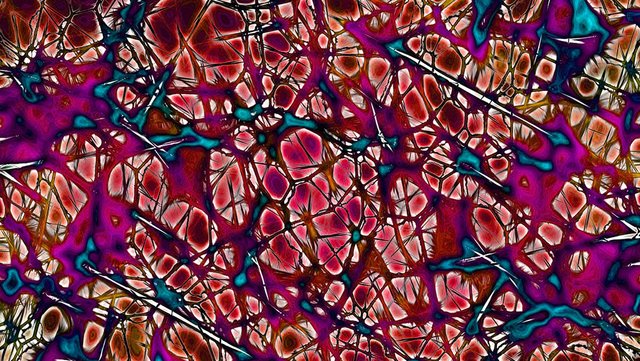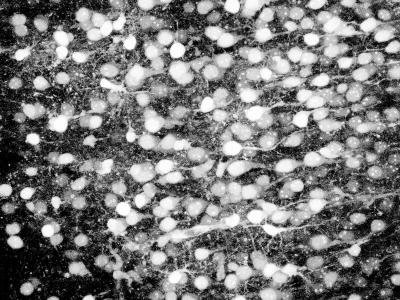Brain Cells in Mice Reprogrammed With Beam of Light

Neuroscience has been revolutionized in the last decade by the development of optogenetic tools.
Previously, scientists had to open the skull and embed electrodes into living tissue. This was done to stimulate neurons with electricity and measure their response. A mouse brain is nearly a thousandth the size of ours, and they have approximately 100 million neurons. This is far too dense to get a close look at specific groups of neurons.
With optogenetics, researchers can get to the inside of the brain non-invasively. Control using this method is also far more accurate. Sight has been restored to blind mice in the last decade and hearing to deaf ones. To take things a step further, normal mice have been turned aggressive. This was done by manipulating specific brain regions using optogenetics.
In the 1940s, psychologist Donald Hebb hypothesized that groups of activated neurons may form the basic building blocks of learning and memory. Findings by neuroscientists at Columbia University suggests that this hypothesis may be correct. The researchers found that if just one neuron in the network was stimulated, a set of neurons trained to fire in unison could be reactivated as much as a day later. It suggests that the three-pound gray computer in our heads is more malleable than we may think.

In this image of living mouse neurons, calcium imaging techniques record the firing of lone neurons and their pulses of electricity. (Image credit: Yuste Laboratory/Columbia University)
By injecting the mouse with a virus that contains light-sensitive proteins created to reach specific brain cells, the team was able to control and observe the brain of a living mouse. The researchers were able to activate the neuron remotely with light once it was inside a cell. The study's senior author, Dr. Rafael Yuste, a neuroscience professor at Columbia University commented that he had always been under the impression that the brain was mostly hard-wired. The results of the study however shows that the brain acts like a plastic computer that's constantly learning and changing.
During the study, the mouse’s head was held still under a microscope while it was allowed to run freely on a treadmill. The researchers used two lasers. The first was used to beam light through its skull to stimulate a small group of cells in the visual cortex, while they recorded rising levels of calcium in each neuron as it fired, with the second. This two-laser arrangement allowed them to image the activity of individual cells.
It took more than a decade of work before researchers reached this breakthrough of being able to reprogram a cluster of cells in the brain. In a 2003 study published in Nature by Yuste and his colleagues, they showed that neurons coordinated their firing in small networks called neural ensembles. They also demonstrated a year later that the ensembles fired off in sequential patterns through time.
With improved techniques for controlling and observing cells in living animals, it was later discovered that these neural ensembles are active even without stimulation. This information was used to develop mathematical algorithms for finding neural ensembles in the visual cortex. As they had done with the tissue samples earlier, the algorithms enabled them to prove that neural ensembles in living animals also fire one after the other in sequential patterns.
Yuste noted that the latest study shows that these networks can not only be artificially implanted but also replayed. The researchers documented how individual cells responded to light stimulation by pairing two-photon calcium imaging with two-photon stimulation technology. Previous studies, though targeting and recording individual cells, have not demonstrated that a bundle of neurons can be fired off together to imprint what is called a "neuronal microcircuit" in a live animal's brain.
Stimulating only 20 neurons in a mouse brain of 100 million neurons is equivalent to reconfiguring three grains of sand at the beach. Yuste, who is also a member of the Data Science Institute, explained that although he would not have believed this to be possible a year ago, that is exactly what the team has managed to do.
What is interesting is that the network of activated neurons that the researchers artificially created may have implanted an image completely unfamiliar to the mouse. A behavioral study will however need to be created before an attempt can be made to try to prove this.
The study's lead author, Luis Carrillo-Reid, a postdoctoral researcher at Columbia, believes the results will have a major impact in neuroscience and medicine.
One of the potential applications could be to restore normal connection patterns in the brains of people with brain disorders such as epilepsy. There are however some major technical hurdles that will have to be overcome before optogenetic techniques can be applied to human brains.
Fully detailed study has been published in the journal Science.

Like what you read (without annoying ads :) ) ? Then please upvote our posts and follow us for the best daily science news on SteemIt!
Hi! I am a content-detection robot. This post is to help manual curators; I have NOT flagged you.
Here is similar content:
http://sciencenewsjournal.com/brain-cells-mice-reprogrammed-beam-light/